How understanding your gear can help you make better choices when mixing and even make you a better mixing engineer.
When it comes to mixing, analogue gear (and plugin emulations) are great for adding a certain vibe or sound to your mix. Given a lot of the charm of analogue comes from its unpredictable nature; it is good to mix on ‘feel’ when using this gear. However, part of the role of the mixing engineer is to also understand why it sounds the way it does.
While there are a number of factors that contribute to the ‘character’ of a piece of gear, the way it reproduces frequencies across the spectrum (it’s frequency response) is an important element. Most people associate the term ‘frequency response’ with pieces of gear such as microphones and monitors, however, it is also relevant to many other pieces of studio equipment.
TAPE MACHINES
Tape saturation is a popular tool. I’m a big fan of the UAD Studer A800 and Slate Digitals VTM for adding some extra warmth to the mix or smoothing out the top end. But why is it that tape (and the tape machine itself) has these effects on audio?
If you look at the frequency response of these recorders, you will see that most tape machines have a ‘low-end bump’ (boosting certain low frequencies by around +2db) and differing curves in the high frequencies. This is why, when a mixing engineer places a tape emulator the mix buss, the bass suddenly feels fuller (or it may make the mix feel muddier).

McDSP’s Analogue Channel 2 (AC202) actually shows you the curve of its low-end ‘bump’ and allows you to adjust it accordingly.
Alternatively, changing settings such as tape speed (IPS) can have noticeable changes to the top end of your audio.
For example, at 15 IPS on the Studer A800 (GPS tape), there is a slight dip between 5 and 10 khz. Switching to 30 IPS, which is has a much flatter response in that area, can make for a brighter (or harsher, depending on your taste) sound. If you’re new to Studer, check out this video for examples:
For a better look at the frequency responses of a range of tape machines, mixing engineer and tech Jack Endino published a great article with detailed test results.
PREAMPS AND CONSOLES
The tubes and transistors used in many popular preamps and consoles have their own sonic qualities as well. They may react differently depending on how much input you feed them. Not only do they add artefacts such as harmonic distortion, they also have unique frequency responses.
Slate Digital’s Virtual Console Collection is a great plugin that emulates 6 top analogue desks. It is perfect for avoiding an overly ‘digital’ sounding mix or adding some vibe to individual channels.
Each console acts differently. For example, the US A (modelled on an API desk) can help add some weight and power to drums, while the Brit N (Neve emulation) sounds great on bass. Again, part of the reason for this is because of the frequency responses of these circuits. For a full break down on each emulation, Sound On Sound did some great modelling of the frequency response of each console.
CONCLUSION
It is not essential to understand exactly what is going on inside your gear (or plugins). After all, what really matters is how they sound. However, understanding the basic workings of the gear you use can be invaluable. It may even be what sets you apart as a mixing engineer.
The more you understand what you are doing to your audio, the better choices you can make whilst mixing. A general rule of thumb I like to use is: if you are adding something to a track, there should be a reason for it. As I have said before, as a mixing engineer you should do no harm. If you understand what your gear adds (or subtracts) from the audio, you’ll be much better placed to do the creative things well and quickly.
If you’re looking for ways you can use analogue gear or plugin emulations to shape your mix, or can’t quite sculpt the sound you’d like, get in touch and I’d be happy to help.

